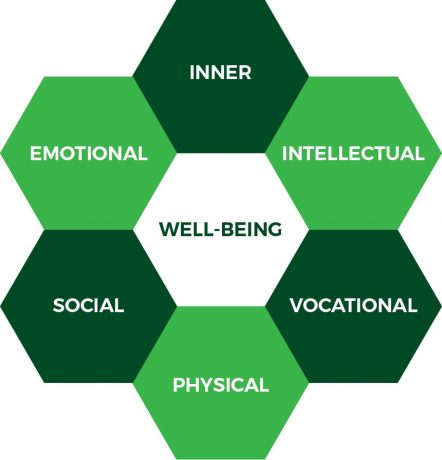
Delhi2:07 AM | 27th April 2024
Ensuring well-being of an organization and its key stakeholders has always been a priority for all concerned but has now become urgent in the current aftermath of Covid19 pandemic.

Ensuring well-being of an organization and its key stakeholders has always been a priority for all concerned but has now become urgent in the current aftermath of Covid19 pandemic. Leading the organization towards achieving organizational goals can only be achieved if all employees and other important stakeholders are happy, satisfied, motivated and aligned. Taking care of their safety and wellness – physical, psychological, emotional and spiritual wellbeing –should always be given high priority even as the spread of the COVID pandemic is disrupting life and businesses in India and elsewhere in the world.

Around the world, employers are increasingly worried about the well-being issues presented by the escalating Covid19 pandemic. This pandemic brings serious physical health consequences for our workforce, customers and other stake holders. The associatedmental health implications – reflected by stress, fear, depression and uncertainty – can also be equally devastating. Organization leaders are required to improve the well-being of workforce as we navigate a course through this extraordinary era of uncertainties and global challenges. Depending on their sector, the current crisis has hit organizations very differently. But the single common factor for everyone is that life is perceived to be more stressful for most of the people.
Some effective HR and other strategies for promoting wellbeing among employeesare suggested as follows:
Employee engagement and organizing webinars /educative programs on emotional hygiene as employees work from home.
Clear, flexible and employee friendly work from home policies.
Tying up with external agencies for tips and support on indoor exercises, yoga etc. to ensure physical wellbeing.
Promoting meditation and mindfulness to help employees and other important stakeholders to live in the present moment and thus, also enhancing their capability to cope up with difficult and uncertain situations.
Initiatives to promote employee health and safety while they work from home during the lockdown.
‘Telemedicine Program’ globally to help the employees and their families with questions about their physical and mental health.
Further strengthen online Employee assistance program (EAP).
Encouraging employees across the organization to take a ‘Digital Chai Break’ and guiding them in scheduling their workday as per their passion.
Encouraging the working parents to bring their young kids to greet colleagues during video meetings. This will build a strong sense of togetherness.
Putting employee well-being ahead of productivity issues and offer psychological counselling helplines to people facing anxiety and stress-related problems along with online meditation and fitness sessions to a series of engagement activities during work for home to keep their employees motivated and engaged.
Other concerns connected to the spread of COVID-19 include the profound way the pandemic has affected the way companies operate. In a matter of days, organizations around the world transitioned millions of employees to remote working to keep their communities safe. How businesses respond during this crisis will have a lasting impact on employee engagement, productivity, and retention. Those now working remotely face the mental stress of isolation and the physical challenges of new workspaces – kitchen tables, bedrooms and garages – that are far from being appropriate for this purpose. Staff may also be juggling business commitments with increased childcare and home-schooling responsibilities, and worries about older, immune compromised or absence of friends and family members.
All organizations expressed that saving human capital and well-being of employees is the most crucial task before their managers and HR leaders. Organizations have come up with novel ideas ranging from doctors-on-call, psychological counselling and online meditation and fitness sessions to virtual team lunches and dedicated ‘work for home’ hours to help in household work – the sole aim being employee motivation and engagement.
Over the last couple of months, we have seen many of our enterprise customers depend on learning to build organizational resilience. Learning-oriented leaders across companies are on the frontlines providing employees with the support they need in adapting to the new normal.
Big conglomerates and new-age companies alike are putting employee well-being ahead of productivity issues and have come up with various initiatives such as virtual connect sessions including chai and lunch breaks, insurance plans for Covid-19, doctors-on-call and mental counselling helplines, and online fitness and learning sessions. Many have also paid their employees advance salary before the end of March.
In the toughest times the human spirit dictates that leaders will emerge, often from the most unexpected places. Supporting wellbeing effectively requires a holistic approach that addresses mental health and engagement with the psychosocial considerations in this new working environment.

Leaders of the organization should also be focusing on protecting both mental and physical health:
Besides physical protection measures, these leaders must make sure that employees know where to find information, guidance, and support for mental health. Maintain open channels of communication to hear how employees are feeling and, importantly, listen and respond. Consider establishing a hotline, toll free number or central contact point for employees and develop in-house channels and hubs to respond promptly to employee questions and concerns. Positive and assuring communication during this time can play an important role.
Organizations cannot rely on people to self-report:
Two-way conversations are essential to building trust. It is vital to monitor mental well-being with structured regular opportunities for employees to ‘check-in’ with managers and colleagues and encourage peer support. Share techniques to stay calm, present, and focused. Reinforce the importance of being physically active to reduce stress and mindfulness for mental clarity. Make everyone aware that significant changes in a team member’s personality or decreased work output may be signs that a person is struggling. If possible, leverage analytics to identify vulnerable ‘hot spots’. Put mechanisms in place to ensure at-risk employees are reached out to immediately with empathy and concerns going way beyondmere practical solutions.
Keep your staff connected and feeling supported in isolation:
Research in Hong Kong after the 2003 SARS outbreak found that increased social connectedness offsets the negative mental health impacts of the pandemic. For many people, connection with colleagues can provide an important buffer to their feelings of social isolation and disconnect. Encourage employees to stay regularly connected with virtual video meetings. With employees feeling overwhelmed and anxious, ask people leaders to make themselves available to staff to talk about their fears, answer questions and reassure them about work and personal issues. When people are working remotely it is more important than ever to routinely check in, not only about work, but also to see how people are doing. Ask direct questions like — How are you managing? What would you most like support with at the moment?
Boosting motivation and engagement:
It’s hard to find the energy to remain motivated in a time of crisis. Setting a clear and short roadmap and an empowering vision for your organization’s objectives will mobilize and motivate your employees around a common goal. This is also a good time to re-articulate your values, which helps to keep people grounded in the familiar and give them a roadmap for navigating uncertainty.
As you clarify plans to lead through this period of change, align your approach for managing COVID-19 with your broader purpose. Embed your organizational purpose and values into all communications as you share your roadmap across the organization. Provide recognition and ‘shout-outs’ for those who are living these values during this time.
Keep communicating, even when you don’t have all the answer. If you say nothing people fill the gaps with conjecture and worry.
Foster resilience and performance:
The sudden shift to working from home has the potential to derail performance. Make sure employees have sufficient infrastructure, flexibility and support to do their job to the best of their ability under the current circumstances. In these extraordinary times, we need to acknowledge different work patterns, different skill sets, particularly around remote working and virtual teaming. Empower your middle management – a highly influential cohort – to drive new ways of working. Consider opportunities to upskill employees and cross skill teams.
Provide access to tools and online learning platforms to empower employees, increase organizational capability, workforce flexibility and resilience. Employee engagement will be improved where they can form part of the overall organizational solutions.
Importantly, no matter what disruptive forces and how stressful the scenario is, humans are at the center of every organization. In the toughest times, the human spirit dictates the emergence of leaders, often from the most unexpected places. To nurture these fledgling leaders in your organization, direct all support to empower them and make their efforts self-sustaining. We must encourage individual employees to take ownership and accountability for their own well-being so they come through the crisis more resilient than when they went in.
At our IIHMR University, we have used this crisis as an opportunity. We have developed online courses, organized strategy meetings, research meetings, webinars etc using our IT resources. Our research and publications are currently at the highest peak. We have adopted flexible and employee friendly policies for work from home, providing required resources and creating an enabling ecosystem, which has enabled high level of learning and growth, better processes, customer delight and financial outcomes also (following the balanced score-card model).
Well-being is a much deeper word as compared to welfare. For well-being, a person has to take self-responsibility towards living a happy and fulfilled life. If focus is purely external, people can easily get upset with so many uncertainties floating around. But if we focus on ‘being’ and our focus is internal, it can lead to nurturing a mindset which is ‘Sthithpragya’ or aiming for the same level of inner bliss inspite of outside situation or stimulus. Hence there is a big need for inner journey, self-love, meditation and mindfulness that can definitely play an important role in nurturing well-being in an organization.
In conclusion, I would like to quote Shiv Agarwal (Managing Director, ABC Consultants) who remarked that ‘in a crisis, leaders do not manage a business. They run a family’. If such an approach is followed and if employees are taken care of like a family, business will develop a lot of heart capital that will blossom and lead to better productivity.
The article is Co-authored by Raghu Prasad, Head HR,
IIHMR University, Jaipur
Copyright© educationpost.in 2024 All Rights Reserved.
